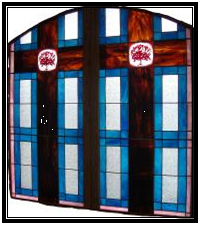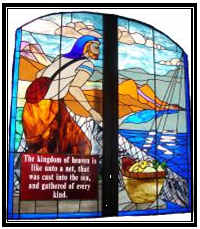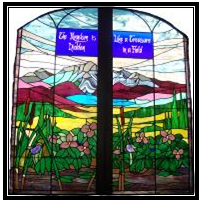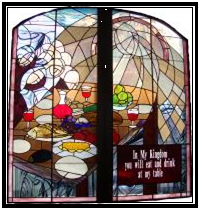|
The Stained Glass Windows
The church features several memorial stained glass windows.
The first, depicting the Good Samaritan was erected in 1904 in memory of George Bryce, the president of the first Board of Managers.
The second was erected in memory of Harvey McLean, a faithful adherent whose wife, Vallera, was the church organist and choir leader for many years.
|




|
Enter Into His Gates With Thanksgiving
The centre section of this window shows the gates of the Kingdom of Heaven. The two outside sections are symbolic of gothic rose windows. The twelve spokes in each wheel represent the creative order embodied in numbers, the twelve apostles. The universe is manifested in the concentric layers which are symbols of the sun, moon, planets and stars. This window is located in Saint Andrew's Hall. |
|
The Kingdom is Like a Treasure Hidden in a Field
The majesty of British Columbia was the motivating force that shaped this window. The concept of uniting the beauty of our Earth with that of the Kingdom was an easy second step. The Kingdom is there for those who choose to look. The actual scene is not any particular place. The mountains are B.C., but the trilliums and rushes could be Ontario as well. The trilliums with their three petals were chosen to represent the holy trinity and if you look closely you will see a little treasure hidden on one of the rush stems. Part of the verse appears in each side of the window. You may interpret the verse by reading horizontally or you may read each section separately. |
|
In My Kingdom You Will Eat and Drink at My Table
This window shows what we will meet when our time on Earth has ended and we have reached "The Table" in the Kingdom. The stylized figures are not representative of male or female, young or old, or race or creed. Some of these forms are represented by only a curved line suggesting the continuous procession of people entering the Kingdom. A mother-of-pearl, streaky-black glass used around the figures represents that nebulous area between Earth and Heaven. The window lightens from bottom to top, from Earth to Heaven. The window shows the "presence" of God rather than a definite form. Heaven is all encompassing; it is a place of protection, gathering, and nurturing. |
|
The Kingdom of Heaven is Like Unto a Net, That Will Cast into the Sea and Gather of Every Kind
Except for the blue head scarf, the fisherman's clothing suggests a common man. His beard and clothing are similar to the landscape, suggesting a connection between the figure and the Earth. The fish are varied. According to St. Matthew, when the net was full, it was drawn to shore and the good fish gathered into vessels, but the bad fish were cast away. The rolling landscape gives a sense of calmness. The sunlight glitters on the waves, perhaps a benediction to those good fish being gathered in. The blue sky suggests all is well; however, a vague area of greyness appears over the far hills. |
|
The Burning Bush
As Knox Presbyterian Church had four front windows, this final one made the front facade of the church complete, a gift from the congregation. The burning bush depicted in the window is a symbol of the Presbyterian Church. The burning bush is an object described in the Book of Exodus (3:1-22). It was located on Mount Horeb, where God appointed Moses to lead the Israelites out of Egypt into Canaan. The inscription Nee Tamen Consumbatur refers to the bush that burns but is not consumed, as will be the church that will last forever. |




